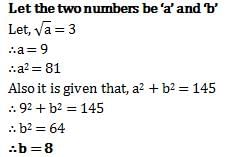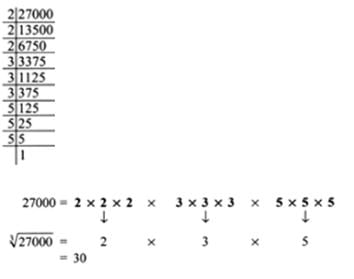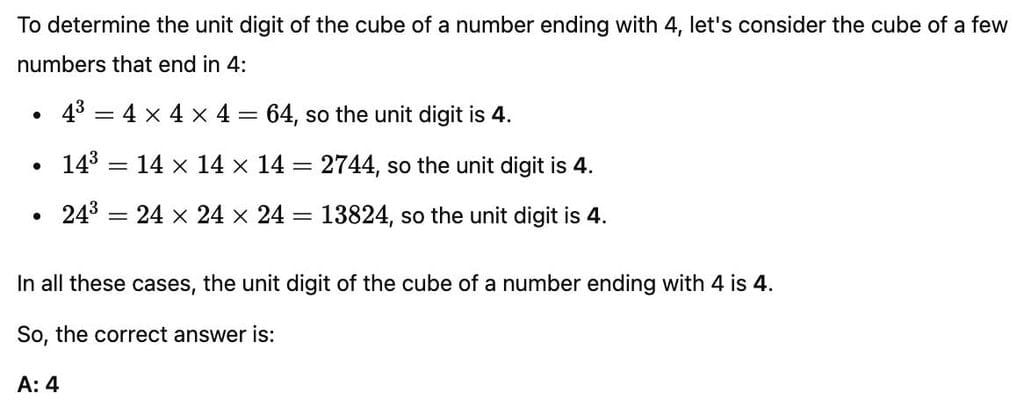All Exams >
GMAT >
Quantitative for GMAT >
All Questions
All questions of Square Roots and Cube Roots for GMAT Exam
36 x K is a perfect cube number, then K = ______a)6b)5c)4d)3Correct answer is option 'A'. Can you explain this answer?
|
|
Kavya Saxena answered |
6×6=36 and 36×6=216, which is the cube of 6.
How many natural numbers lie between 92 and 102?
a) 36
b) 27
c) 9
d) 18
Correct answer is option 'D'. Can you explain this answer?
|
|
Sohini Das answered |
Between 92 and 102
Here, n = 9 and n + 1 = 10
∴ Natural number between 92 and 102 are (2 × n) or 2 x 9, i.e. 18.
Here, n = 9 and n + 1 = 10
∴ Natural number between 92 and 102 are (2 × n) or 2 x 9, i.e. 18.
Which of the following is a perfect square number?
- a)222222
- b)23453
- c)1681
- d)1057
Correct answer is option 'C'. Can you explain this answer?
Which of the following is a perfect square number?
a)
222222
b)
23453
c)
1681
d)
1057

|
Shashwat Singh answered |
The answer is 1681 because it is the only number which has it's last digit as a number which a perfect square can have . 9×9=81 the last digit is 1.
Find the perfect square number between 30 and 40.
- a)36
- b)49
- c)25
- d)none of these
Correct answer is option 'A'. Can you explain this answer?
Find the perfect square number between 30 and 40.
a)
36
b)
49
c)
25
d)
none of these
|
|
Amita Verma answered |
Since, 1 x 1 = 1
2 x 2 = 4
3 x 3 = 9
4 x 4 = 16
5 x 5 = 25
6 x 6 = 36
7 x 7 = 49
Thus, 36 is a perfact square number between 30 and 40.
Which of the following would end with digit 1?- a)1232
- b)1612
- c)772
- d)822
Correct answer is 'B'. Can you explain this answer?
Which of the following would end with digit 1?
a)
1232
b)
1612
c)
772
d)
822

|
Sneha Singh answered |
Option B is correct because the unit digit of 161 is 1 and if unit digit of any digit ends with 1 the its square will also end with 1.
Without doing any calculation, find the numbers which are surely perfect squares.- a)441
- b)408
- c)153
- d)257
Correct answer is option 'A'. Can you explain this answer?
Without doing any calculation, find the numbers which are surely perfect squares.
a)
441
b)
408
c)
153
d)
257

|
KS Coaching Center answered |
The perfect squares have 0,1,2,4,5,6 or 9 at their units place.
Therefore153,257 and 408 are surely not perfect squares.
Therefore153,257 and 408 are surely not perfect squares.
Without adding, find the sum. 1 + 3 + 5 + 7 + 9 + 11 + 13
- a)36
- b)49
- c)25
- d)19
Correct answer is option 'B'. Can you explain this answer?
Without adding, find the sum. 1 + 3 + 5 + 7 + 9 + 11 + 13
a)
36
b)
49
c)
25
d)
19

|
Zzz answered |
We have to just add that how many odd no. are ther... moree then we have to take out
Without adding, find the sum. 1 + 3 + 5 + 7 + 9- a)16
- b)36
- c)9
- d)25
Correct answer is option 'D'. Can you explain this answer?
Without adding, find the sum. 1 + 3 + 5 + 7 + 9
a)
16
b)
36
c)
9
d)
25

|
Lakesway Classes answered |
Here, we have to find the sum of first five odd natural numbers.
Therefore, 1 + 3 + 5 + 7 + 9 = (5)2 = 25
Ones place digit in the cube of 5832 is ______.- a)5
- b)7
- c)2
- d)8
Correct answer is option 'D'. Can you explain this answer?
Ones place digit in the cube of 5832 is ______.
a)
5
b)
7
c)
2
d)
8

|
Shiksha Academy answered |
A number ending with 1 , 2 , 3 , 4 , 5 , 6 , 7 , 8 , 9 , 0 then it's cube ends with 1 , 8 , 7 , 4 , 5 , 6 , 3 , 2 , 0 respectively
⇒ One's digit of 5832= 2
⇒ Cube of 2=23 = 8
⇒ Cube of 2=23 = 8
So, the one's digit of cube of 5832=8
A natural number is said to be a perfect cube, if it is the cube of some ________.- a)cube number
- b)square numbers
- c)natural number
- d)none of these
Correct answer is 'C'. Can you explain this answer?
A natural number is said to be a perfect cube, if it is the cube of some ________.
a)
cube number
b)
square numbers
c)
natural number
d)
none of these
|
|
Kavya Saxena answered |
A natural number is said to be a perfect cube if it is the cube of some natural number.
Example
8 = 2 x 2 x 2
8 = 2 3
8 is the perfect cube because it is a cube of 2 which is a natural number.
But 12 is not a perfect cube because it is not a cube of any natural numbers.
Example
8 = 2 x 2 x 2
8 = 2 3
8 is the perfect cube because it is a cube of 2 which is a natural number.
But 12 is not a perfect cube because it is not a cube of any natural numbers.
Find the prime factorisation of 175616.- a)23×33×33×73
- b)23×23×23×73
- c)23×23×33×73
- d)23×33×53×73
Correct answer is option 'B'. Can you explain this answer?
Find the prime factorisation of 175616.
a)
23×33×33×73
b)
23×23×23×73
c)
23×23×33×73
d)
23×33×53×73

|
Ashwin Jain answered |
Prime factor tree of 175616:
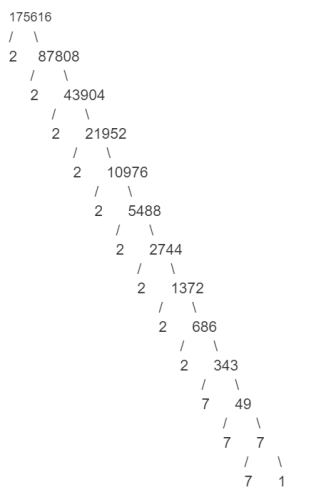
So, its prime factorisation is: 2^3 x 2^3 x 2^3 x 7^3.
Without adding, find the sum of 1 + 3 + 5 + 7 + 9 + 11 + 13 + 15 + 17 + 19
- a)100
- b)64
- c)49
- d)81
Correct answer is option 'A'. Can you explain this answer?
Without adding, find the sum of 1 + 3 + 5 + 7 + 9 + 11 + 13 + 15 + 17 + 19
a)
100
b)
64
c)
49
d)
81

|
Target Study Academy answered |
Total consecutive odd numbers = 10
Thus n = 10
Therefore sum = n × n
= 10× 10 = 100
What is the least perfect square which is divisible by 2, 4 and 6?
- a)36
- b)64
- c)16
- d)18
Correct answer is option 'A'. Can you explain this answer?
What is the least perfect square which is divisible by 2, 4 and 6?
a)
36
b)
64
c)
16
d)
18
|
|
Preeti Khanna answered |
LCM of 2,4,6= 2×1×2×3=12
Least perfect square which is a multiple of 12 is 36.
Least perfect square which is a multiple of 12 is 36.
What is the cube of double of ‘a’?- a)16a3
- b)2a
- c)8a3
- d)4a2
Correct answer is option 'C'. Can you explain this answer?
What is the cube of double of ‘a’?
a)
16a3
b)
2a
c)
8a3
d)
4a2
|
|
Vivek Rana answered |
Double of a here a+a=2a
So cube of (2a)³=8a³
Find the square of 39.- a)1500
- b)78
- c)1521
- d)none of these
Correct answer is option 'C'. Can you explain this answer?
Find the square of 39.
a)
1500
b)
78
c)
1521
d)
none of these
|
|
Ananya Das answered |
(40-1)2 = 1600+1-80 = 1521
Find the least number that must be subtracted from 5607 so as to get a perfect square.- a)130
- b)135
- c)131
- d)none of these
Correct answer is option 'C'. Can you explain this answer?
Find the least number that must be subtracted from 5607 so as to get a perfect square.
a)
130
b)
135
c)
131
d)
none of these

|
Sounak Sengupta answered |
Square of 75 is 5625
square of 74 is 5476
so use must get 5476
5607 - x is 5476
x is 131
square root of 5476 is 74
Practice Quiz or MCQ (Multiple Choice Questions) with solutions are available for Practice, which would help you prepare for chapter Squares and Square Roots, Class 8, Mathematics . You can practice these practice quizzes as per your speed and improvise the topic.Q.Which of the following is a perfect square number?- a)222222
- b)23453
- c)1681
- d)1057
Correct answer is 'C'. Can you explain this answer?
Practice Quiz or MCQ (Multiple Choice Questions) with solutions are available for Practice, which would help you prepare for chapter Squares and Square Roots, Class 8, Mathematics . You can practice these practice quizzes as per your speed and improvise the topic.
Q.
Which of the following is a perfect square number?
a)
222222
b)
23453
c)
1681
d)
1057

|
Sanjana Bose answered |
A number is a perfect square (or a square number) if its square root is an integer; that is to say, it is the product of an integer with itself. Here, the square root of 1681 is 41.
Therefore, the square root of 1681 is an integer, and as a consequence 1681 is a perfect square.
As a consequence, 41 is the square root of 1681.
2025 plants are to be planted in a garden in such a way that each row contains as many plants as the number of rows. Find the number of plants in each row.
- a)55
- b)65
- c)45
- d)none of these
Correct answer is option 'C'. Can you explain this answer?
2025 plants are to be planted in a garden in such a way that each row contains as many plants as the number of rows. Find the number of plants in each row.
a)
55
b)
65
c)
45
d)
none of these
|
|
Rajeev Kumar answered |
Let the number of rows be x
Thus, the each row contains x plants.
The total number of plants in the garden = number of rows × number of plants in each rows
Thus,
2025=x×x
=>x2 =2025
=>x= 3×3×3×3×5×5
=3×3×5
=45
Thus, there are 45 rows and each row contains 45 plants.
Thus, the each row contains x plants.
The total number of plants in the garden = number of rows × number of plants in each rows
Thus,
2025=x×x
=>x2 =2025
=>x= 3×3×3×3×5×5
=3×3×5
=45
Thus, there are 45 rows and each row contains 45 plants.
The cube of an even number is always ____________.- a)odd number
- b)even number
- c)prime number
- d)none of these
Correct answer is option 'B'. Can you explain this answer?
The cube of an even number is always ____________.
a)
odd number
b)
even number
c)
prime number
d)
none of these

|
Biswa Ranjan Parida Pari answered |
Because multiplication of even number is always even.
for ex 2³=2.2.2=8
for ex 2³=2.2.2=8
Express 63 as the sum of odd numbers.- a)31 + 33 + 35 + 37 + 39 + 41 + 43
- b)31 + 33 + 35 + 37 + 39 + 41
- c)31 + 33 + 35 + 37 + 39 + 41 + 43 + 45
- d)none of these
Correct answer is option 'B'. Can you explain this answer?
Express 63 as the sum of odd numbers.
a)
31 + 33 + 35 + 37 + 39 + 41 + 43
b)
31 + 33 + 35 + 37 + 39 + 41
c)
31 + 33 + 35 + 37 + 39 + 41 + 43 + 45
d)
none of these
|
|
Pooja Shah answered |
We know,
⇒ 31 + 33 + 35 + 37 + 39 + 41 = 216
And the cube of 6 is also 216
⇒ 6 × 6 × 6 = 216
By which smallest natural number 392 must be multiplied so as to make the product a perfect cube ?- a)2
- b)14
- c)7
- d)49
Correct answer is option 'C'. Can you explain this answer?
By which smallest natural number 392 must be multiplied so as to make the product a perfect cube ?
a)
2
b)
14
c)
7
d)
49
|
|
Ananya Das answered |
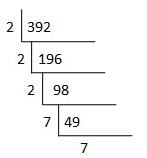
392 = 2 × 2 × 2 × 7 × 7
Hence the number should be multiplied by 7 to make it a perfect cube.
Practice Quiz or MCQ (Multiple Choice Questions) with solutions are available for Practice, which would help you prepare for chapter Squares and Square Roots, Class 8, Mathematics . You can practice these practice quizzes as per your speed and improvise the topic.Q.Which of the following is a perfect square number?- a)222222
- b)23453
- c)1681
- d)1057
Correct answer is option 'C'. Can you explain this answer?
Practice Quiz or MCQ (Multiple Choice Questions) with solutions are available for Practice, which would help you prepare for chapter Squares and Square Roots, Class 8, Mathematics . You can practice these practice quizzes as per your speed and improvise the topic.
Q.
Which of the following is a perfect square number?
a)
222222
b)
23453
c)
1681
d)
1057
|
|
Kavya Saxena answered |
The answer is 1681 because it is the only number which has it's last digit as a number which a perfect square can have . 9×9=81 the last digit is 1.
How many numbers lie between square of 12 and 13- a)22
- b)23
- c)24
- d)25
Correct answer is option 'C'. Can you explain this answer?
How many numbers lie between square of 12 and 13
a)
22
b)
23
c)
24
d)
25
|
|
Rhea Reddy answered |
122 = 12*12 = 144
132 = 13*13 = 169
Now numbers are between144 and 169 are:
145, 146, 147,.............168
Total number = 24
So total numbers lies between 144 and 169 is 24
Find the square root of 529.
- a)24
- b)23
- c)25
- d)none of these
Correct answer is option 'B'. Can you explain this answer?
Find the square root of 529.
a)
24
b)
23
c)
25
d)
none of these
|
|
Rajeev Kumar answered |
Square root of 529 is 23
729 is the value of _______________.- a)83
- b)93
- c)63
- d)43
Correct answer is option 'B'. Can you explain this answer?
729 is the value of _______________.
a)
83
b)
93
c)
63
d)
43
|
|
Rhea Kaur answered |
To determine the value of 729, we need to examine the options given in the question and choose the correct one.
Let's analyze each option:
a) 83: This option does not seem to be related to the number 729. The digits in 729 do not match the digits in 83.
b) 93: This option also does not seem to be related to the number 729. Again, the digits in 729 do not match the digits in 93.
c) 63: This option does not seem to be related to the number 729 either. The digits in 729 do not match the digits in 63.
d) 43: This option does not seem to be related to the number 729. Once again, the digits in 729 do not match the digits in 43.
Therefore, none of the options provided correspond to the value of 729. As a result, the correct answer is not given in the options provided.
In conclusion, the given options are incorrect, and there is no correct answer provided for the value of 729.
Let's analyze each option:
a) 83: This option does not seem to be related to the number 729. The digits in 729 do not match the digits in 83.
b) 93: This option also does not seem to be related to the number 729. Again, the digits in 729 do not match the digits in 93.
c) 63: This option does not seem to be related to the number 729 either. The digits in 729 do not match the digits in 63.
d) 43: This option does not seem to be related to the number 729. Once again, the digits in 729 do not match the digits in 43.
Therefore, none of the options provided correspond to the value of 729. As a result, the correct answer is not given in the options provided.
In conclusion, the given options are incorrect, and there is no correct answer provided for the value of 729.
Can you explain the answer of this question below:The numbers 1, 8, 27... are ____________.
- A:
negative numbers
- B:
cube numbers
- C:
square numbers
- D:
none of these
The answer is B.
The numbers 1, 8, 27... are ____________.
negative numbers
cube numbers
square numbers
none of these

|
Saranya Khanna answered |
1×1×1 =1
2×2×2 = 8
3×3×3 = 27
4×4×4 = 64
5×5×5 = 125
The smallest natural number by which 243 must be multiplied to make the product a perfect cube is __________. - a)3
- b)9
- c)8
- d)7
Correct answer is option 'A'. Can you explain this answer?
The smallest natural number by which 243 must be multiplied to make the product a perfect cube is __________.
a)
3
b)
9
c)
8
d)
7

|
Sunita Jain answered |
If we multiply 243by 3 ,we will get,
243×3=729
which is the cube of'7'.
243×3=729
which is the cube of'7'.
What will be the unit digit of ∛216- a)3
- b)6
- c)4
- d)2
Correct answer is option 'B'. Can you explain this answer?
What will be the unit digit of ∛216
a)
3
b)
6
c)
4
d)
2

|
Humaira Tabassum answered |
We can find it by Prime Factorization method
³√216 = 2×2×2×3×3×3
= 2 and 3 are making triplets i.e. 2 and 3
= 2×3 = 6 Thus, we can say that 6 i.e option 'B' is correct.
None of the square numbers end with _________ at unit’s place.
- a)3
- b)2
- c)7
- d)2, 3, 7 or 8
Correct answer is option 'D'. Can you explain this answer?
None of the square numbers end with _________ at unit’s place.
a)
3
b)
2
c)
7
d)
2, 3, 7 or 8
|
|
Preeti Khanna answered |
According to the Property 1, A number having 2, 3, 7 or 8 at it's unit's place is never a perfect square. In other words, no square number ebds in 2, 3, 7 or 8.
What will be the number of zeros in the square of 400?- a)4
- b)1
- c)3
- d)2
Correct answer is option 'A'. Can you explain this answer?
What will be the number of zeros in the square of 400?
a)
4
b)
1
c)
3
d)
2
|
|
Rajeev Kumar answered |
Square of 400 = 160000
Hence, the number of zeroes is 4
Which of the following is a perfect cube ?- a)125
- b)135
- c)145
- d)115
Correct answer is option 'A'. Can you explain this answer?
Which of the following is a perfect cube ?
a)
125
b)
135
c)
145
d)
115
|
|
Athul Sen answered |
Identifying a Perfect Cube
A perfect cube is a number that can be expressed as the product of three identical factors. For example, 27 is a perfect cube because it can be expressed as 3 x 3 x 3. To determine whether a number is a perfect cube, we need to find the cube root of that number. Here, we are given four options, and we can use the cube root method to identify the perfect cube.
Solution
a) 125
The cube root of 125 is 5. Since 125 can be expressed as 5 x 5 x 5, it is a perfect cube. Therefore, option A is the correct answer.
b) 135
The cube root of 135 is approximately 5.5. Since 5.5 is not a whole number, 135 is not a perfect cube.
c) 145
The cube root of 145 is approximately 5.7. Since 5.7 is not a whole number, 145 is not a perfect cube.
d) 115
The cube root of 115 is approximately 4.8. Since 4.8 is not a whole number, 115 is not a perfect cube.
Therefore, the only perfect cube among the given options is 125, which is option A.
A perfect cube is a number that can be expressed as the product of three identical factors. For example, 27 is a perfect cube because it can be expressed as 3 x 3 x 3. To determine whether a number is a perfect cube, we need to find the cube root of that number. Here, we are given four options, and we can use the cube root method to identify the perfect cube.
Solution
a) 125
The cube root of 125 is 5. Since 125 can be expressed as 5 x 5 x 5, it is a perfect cube. Therefore, option A is the correct answer.
b) 135
The cube root of 135 is approximately 5.5. Since 5.5 is not a whole number, 135 is not a perfect cube.
c) 145
The cube root of 145 is approximately 5.7. Since 5.7 is not a whole number, 145 is not a perfect cube.
d) 115
The cube root of 115 is approximately 4.8. Since 4.8 is not a whole number, 115 is not a perfect cube.
Therefore, the only perfect cube among the given options is 125, which is option A.
The cube of an odd number is always __________.- a)odd number
- b)even number
- c)prime number
- d)none of these
Correct answer is option 'A'. Can you explain this answer?
The cube of an odd number is always __________.
a)
odd number
b)
even number
c)
prime number
d)
none of these
|
|
Isha Desai answered |
The cube of a natural odd number is always odd.
For natural numbers, we know,
odd x odd = odd
odd x even = even
even x even = even.
So, cube of a natural odd number is
odd x odd x odd
= odd x odd
= odd.
Eg.: Cube of an odd number 3 is 27, which is also odd.
For natural numbers, we know,
odd x odd = odd
odd x even = even
even x even = even.
So, cube of a natural odd number is
odd x odd x odd
= odd x odd
= odd.
Eg.: Cube of an odd number 3 is 27, which is also odd.
The number of digits in the cube root of a 6-digit number is _______ .- a)3
- b)2
- c)4
- d)6
Correct answer is option 'B'. Can you explain this answer?
The number of digits in the cube root of a 6-digit number is _______ .
a)
3
b)
2
c)
4
d)
6
|
|
Jaideep Nair answered |
As 1003 = 1000000 which is the smallest 3 digit number. So it’s only 2 digit number which is the cube root of a 6 digit number
Find the square root of 729.- a)29
- b)28
- c)27
- d)30
Correct answer is option 'C'. Can you explain this answer?
Find the square root of 729.
a)
29
b)
28
c)
27
d)
30
|
|
Aarav Sharma answered |
The square root of 729 is 27.
What will be the number of zeros in the square of 60?
- a)1
- b)2
- c)3
- d)none of these
Correct answer is option 'B'. Can you explain this answer?
What will be the number of zeros in the square of 60?
a)
1
b)
2
c)
3
d)
none of these

|
Samridhi Patel answered |
Square of 60 is 3600 therefore number of zeroes is 2.
What will be the unit digit of the cube root of a number ends with 2?- a)2
- b)8
- c)4
- d)6
Correct answer is option 'B'. Can you explain this answer?
What will be the unit digit of the cube root of a number ends with 2?
a)
2
b)
8
c)
4
d)
6

|
Sachin Sangamnerkar answered |
Because it's given cube root it will go like this
³√2 = √2
to make it a perfect square we will multiply this 2 by 2 2's again 2 x 2 x 2 = 8
so, option b) 8 is correct
³√2 = √2
to make it a perfect square we will multiply this 2 by 2 2's again 2 x 2 x 2 = 8
so, option b) 8 is correct
Chapter doubts & questions for Square Roots and Cube Roots - Quantitative for GMAT 2025 is part of GMAT exam preparation. The chapters have been prepared according to the GMAT exam syllabus. The Chapter doubts & questions, notes, tests & MCQs are made for GMAT 2025 Exam. Find important definitions, questions, notes, meanings, examples, exercises, MCQs and online tests here.
Chapter doubts & questions of Square Roots and Cube Roots - Quantitative for GMAT in English & Hindi are available as part of GMAT exam.
Download more important topics, notes, lectures and mock test series for GMAT Exam by signing up for free.
Quantitative for GMAT
127 videos|154 docs|111 tests
|

Contact Support
Our team is online on weekdays between 10 AM - 7 PM
Typical reply within 3 hours
|
Free Exam Preparation
at your Fingertips!
Access Free Study Material - Test Series, Structured Courses, Free Videos & Study Notes and Prepare for Your Exam With Ease

 Join the 10M+ students on EduRev
Join the 10M+ students on EduRev
|

|
Create your account for free
OR
Forgot Password
OR
Signup to see your scores
go up
within 7 days!
within 7 days!
Takes less than 10 seconds to signup


